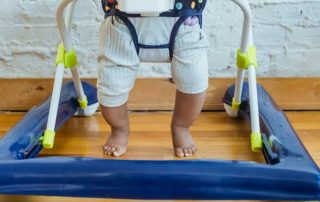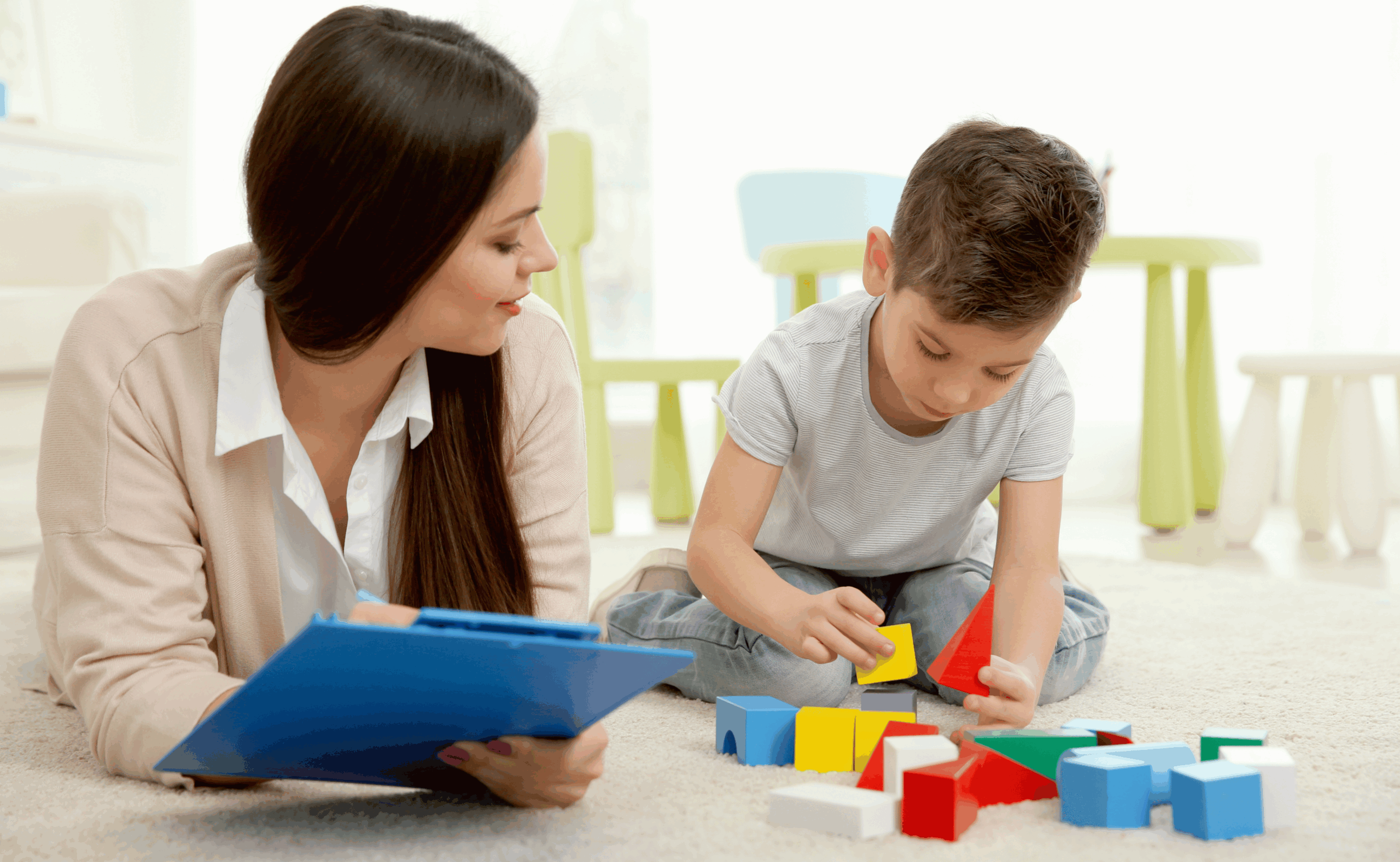Exersaucers, also called activity centers, are a convenient way for busy parents to keep their infants and toddlers happy and entertained. The concept is simple: an enclosed play area where little ones can bounce, spin, and grab onto toys with their hands and feet. But are these stationary activity centers safe? That’s the controversial question that has been hotly debated among pediatricians, child development experts, and parents. To help you make the best decision for your family, we’ve collected information about exersaucer safety concerns and how to use them properly.
Key Takeaway:
- Exersaucers are toys where a baby can sit and walk at the same time – similar to a baby walker.
- Exersaucers are safe for babies only when 1) used properly 2) when baby can at least support their head and neck.
- Never leave your baby unattended, and make exersaucers safe for babies by avoiding putting choking hazards
- There are pros and cons of using an exersaucer. Be sure to be aware before making a decision.
What are Exersaucers?
Exersaucers are stationary activity centers for babies and toddlers. They have different parts, like a seat similar to baby carriers, base, toys, and a bar that goes around the baby. The baby sits in the exersaucer and can play with the toys or bounce on the springs. They’re generally made for infants ages 4-24 months, depending on the height and weight limits of the particular model. At this age, most babies can hold their heads up on their own and sit independently. However, they aren’t quite ready to explore the world by crawling or walking. They usually have three or more positions to adjust as your child grows. This makes it possible for him to use the activity center from 4 months up until he graduates from it at age one or so.
Infant Walkers, Exersaucers, and Controversy
When we talk about exersaucers, we have to start with the controversy over walkers.
Parents loved baby walkers
Before the 1990s, there was no such thing as an exersaucer. Baby walkers were big sellers during that time because they allowed parents to plop their babies down somewhere safe (or so they thought) while they did other things or got a much-needed break.
The AAP cautions against baby walkers
In the early 90’s, a study conducted by the American Academy of Pediatrics (AAP) concluded that a baby walker could be dangerous for many babies. The study suggested that infants in walkers were more likely to suffer from severe injuries that can lead to a medical emergency. The AAP recommended that walkers be banned altogether to prevent more medical emergencies. The conclusion of the study brought on a lot of controversy and led to a debate around infant toys and baby equipment.
Exersaucers enter the market
In the end, it was agreed that the use of baby walkers should be avoided at all costs, but other alternatives for stationary play may still be beneficial for a baby’s development. As a result, exersaucers were developed and marketed as a safer alternative to walkers for babies. EvenFlo released the first exersaucers in the market. Today, many different companies make exersaucers, including Baby Einstein and Fisher-Price, among others.
The Pros and Cons of Exersaucers
Ultimately, parents have the final say about using exersaucers for their babies. And the more information you have, the more confident you’ll be about making the best decision for your child and your parenting journey.
Advantages of Exersaucers
- Develop gross motor skills. Gross infant motor development skills include sitting, standing, and walking. Exersaucers with baby jumpers or jump-and-spin features are beneficial for preparing an infant’s legs for crawling and walking. Some models include stationary activity bases in which children can practice going into a standing position and similar movement patterns. Others have stabilizing legs that help keep a child upright while she plays, so she develops balance, core strength and coordination.
- Develop fine motor skills. This refers to the use of small muscles in the hands, fingers and wrists. Playing with toys on an exerciser’s activity tray is an excellent way to practice these small movements as their bodies develop. Babies learn how to grasp objects with their hands and use them in different ways by playing with toys on an exersaucer activity tray.
- Safer than a baby jumper. It’s important to note that an exersaucer is not for babies who are just learning to hold their heads up and can’t bear weight. Until the baby can support their own head, a jumper can be dangerous. An exersaucer is safer because it has a tray that supports the baby while they play.
- Entertains your baby while you get things done. If you need to get stuff done around the house, exersaucers allow you to do so with your baby safely strapped in the center. It’s easy to prepare dinner, feed younger siblings or just clean up around the house while your little one plays in the exersaucer. However, parents should not use an exersaucer as a replacement for bonding with their baby, and they should still try to dedicate at least a portion of the day to spending time together.
Disadvantages of Exersaucers
- Your child may outgrow it quickly. The first thing you need to know about exersaucers is that your baby will quickly outgrow it. While activity centers can be used starting as early as 6 months, most babies can’t use them until they reach 1 year old or so. Some models state that babies can use them until 24 months, but these models are few and far between and rarely last up until then without losing some of their appeal.
- Limited creativity. If your baby is confined to an exersaucer most of the time, there’s very little opportunity for cognitive development. If a toy is within reach, your baby will simply grab it and play with it. There’s no chance for him to use his imagination or develop new ideas about how to play with items.
- Limited range of motion. Babies can have difficulty developing balance control and practice standing. Saucers may also hinder hip development while encouraging poor habits like toe walking and poor posture. Babies who are able to crawl or walk around on their own often have an easier time developing motor skills than babies whose movements are restricted by saucers and jumpers.
- Excessive stimulation. Babies have very sensitive senses, so all the lights, sounds, and textures found on an exersaucer can be overwhelming. If you place your baby in one of these devices too soon, he may become overstimulated very quickly and start crying or acting fussy and uncomfortable right away.
- May cause flat head syndrome. When a baby spends too much time on his back (or in a seat with his head forward) it may cause flat head syndrome, also known as plagiocephaly. It’s important that your baby get age-appropriate time on his tummy.
- High price tag. Some of the best exersaucers come with hefty price tags, but you can find more affordable options.
How Parents Can Use Exersaucers Safely and Effectively
Baby Safely Playing in an Exersaucer When used properly and for short periods, exersaucers can be a great way to help your baby reach developmental milestones. Follow these practical tips to help ensure your child gets the most from his or her exersaucer without getting hurt:
- Make sure your baby is at least four months old before putting him or her in an exersaucer. This will ensure that your baby’s head and neck muscles are strong enough to support his or her head while bouncing up and down.
- Read the instructions. This is true of any baby product, but especially exersaucers. They come with a lot of pieces and can be tricky to put together.
- Don’t leave your child unattended — even in an exersaucer. Accidents can happen quickly, and babies can get into trouble in the blink of an eye. The exersaucer should always be in your full view so you can monitor what your little one is doing with or to the toy attachments.
- Never put any loose items in the exersaucer, such as toys, stuffed animals or blankets. These items can create a strangulation hazard for babies and toddlers if they get caught in the seat straps or between other pieces of equipment.
- Don’t use it as a babysitter. Exersaucers are designed as a tool for play and exploration, not as a means to leave your baby unattended.
- Use it only on a flat surface. Never use the exersaucer on an elevated surface or near stairs, or while you’re carrying it around.
- Make sure your baby’s feet touch the floor. Your child must be able to push off with his feet to get the most out of the exersaucer, and this also helps him develop body awareness and balance skills.
- Make sure there’s no more than 1 inch of space between his leg and the side of the seat. If your baby is too big for the seat but too small for the floor, he can fall forward out of the exersaucer without enough room to maneuver back into place.
- Follow age guidelines. Don’t use an exersaucer that’s recommended for babies over 6 months if yours is still younger than 4 months old.
Alternatives to Exersaucers
Exersaucer Alternatives for Babies Not convinced about the safety and benefits of exersaucers? Consider these alternatives that promote similar skills:
- Soft-sided activity gym. Hanging toys entertain babies, plus it gives them a cushioned place to lie down and look around.
- Inflatable tummy time mat. Babies with weak neck muscles can practice lifting their head while getting some relief from the pressure of having the baby’s feet on the floor.
- Activity cube. Babies like to explore their environment and this gives them plenty of surfaces and activities to play with.
- Sensory balls. These balls are fun for babies of all ages to explore, from newborns to toddlers. They come in a variety of colors and textures. A bag of balls is also less expensive than an exersaucer.
- Baby-safe fabric books. A book is one of the best ways for your baby to explore her senses at this age. During this stage she can see colors, touch texture and hear sounds when you read aloud. Plus, it’s never too early to create a reader!
- Musical mobiles. Musical toys engage a baby’s senses and promote fine motor skills as she learns how to use them. Some are designed with toys that encourage babies to reach out and grasp them.
FAQs
Are saucers for babies bad for infant motor development?
Exersaucers are safe if used as directed. The American Academy of Pediatrics (AAP) recommends avoiding products that keep a baby in a stationary position for extended periods of time. This recommendation is based on research that is very important to child development. It says babies should be placed in tummy time when awake to help strengthen the neck and shoulders.
Are baby jumpers bad for a baby’s brain?
It is perfectly safe for a baby to use a jumper as long as you are following the recommended guidelines for height, weight, and age.
Why are bouncers not good for a baby’s feet and cognitive skills?
Bouncers should only be used once your baby can sit on their own unassisted and support their own head. Using a bouncer before this time can cause your baby discomfort if they cannot yet sit up straight.
When can my baby start using an exersaucer?
Your baby can use an exersaucer as soon as they are able to sit up on their own without assistance or support from another person or object. This usually happens around 4 months old, but some babies may be ready sooner than others. Check with your pediatrician before starting any exercise routine for your child.
When should I transition my baby out of the exersaucer?
Each child is different, but most are ready by 12 months old. Signs that your child is ready include being able to push themselves up on their hands and knees and creep around on their knees like a puppy, even if they don’t go very far.
Are Exersaucers Safe for Babies?
Because there are so many exersaucer choices available, and because they can be used in so many ways, the best choice for one baby may not work for another. It’s up to you, to choose the best option for your baby and your family – whether that’s bringing an exersaucer home or going with alternatives. You may also want to seek professional medical advice or consult a pediatric physical therapist for better guidance.







